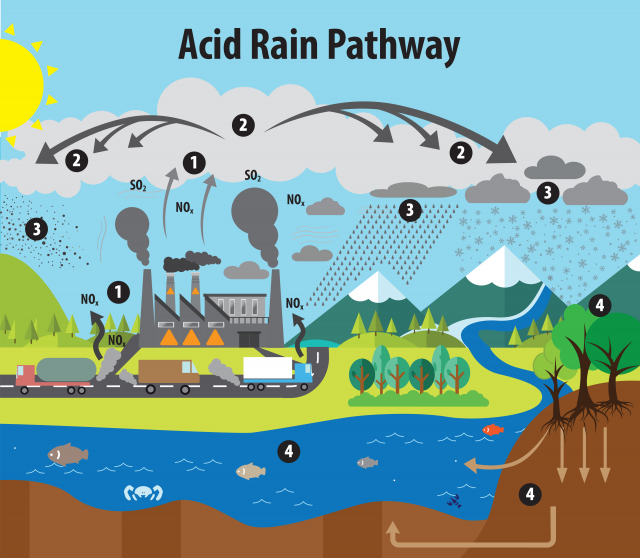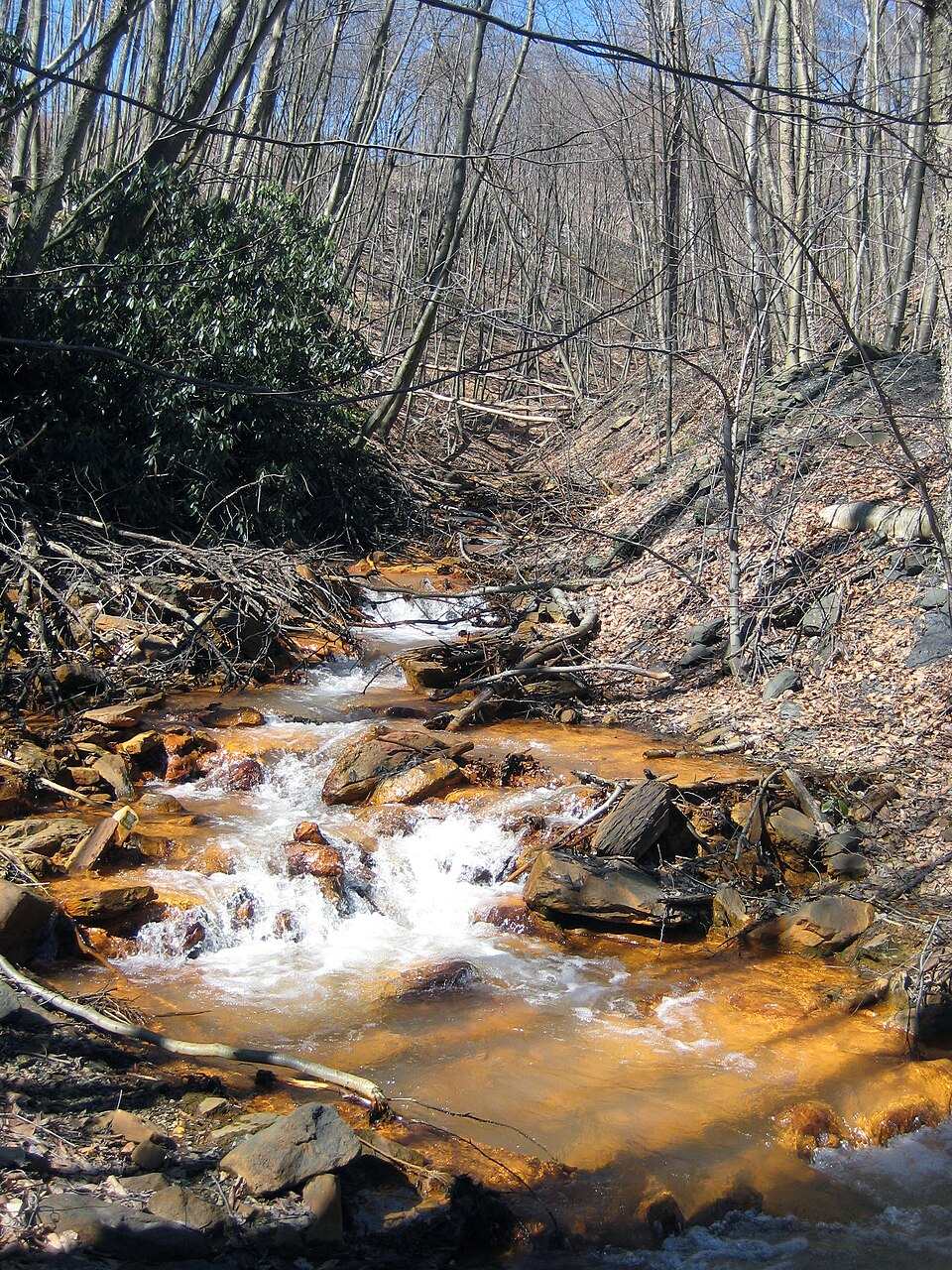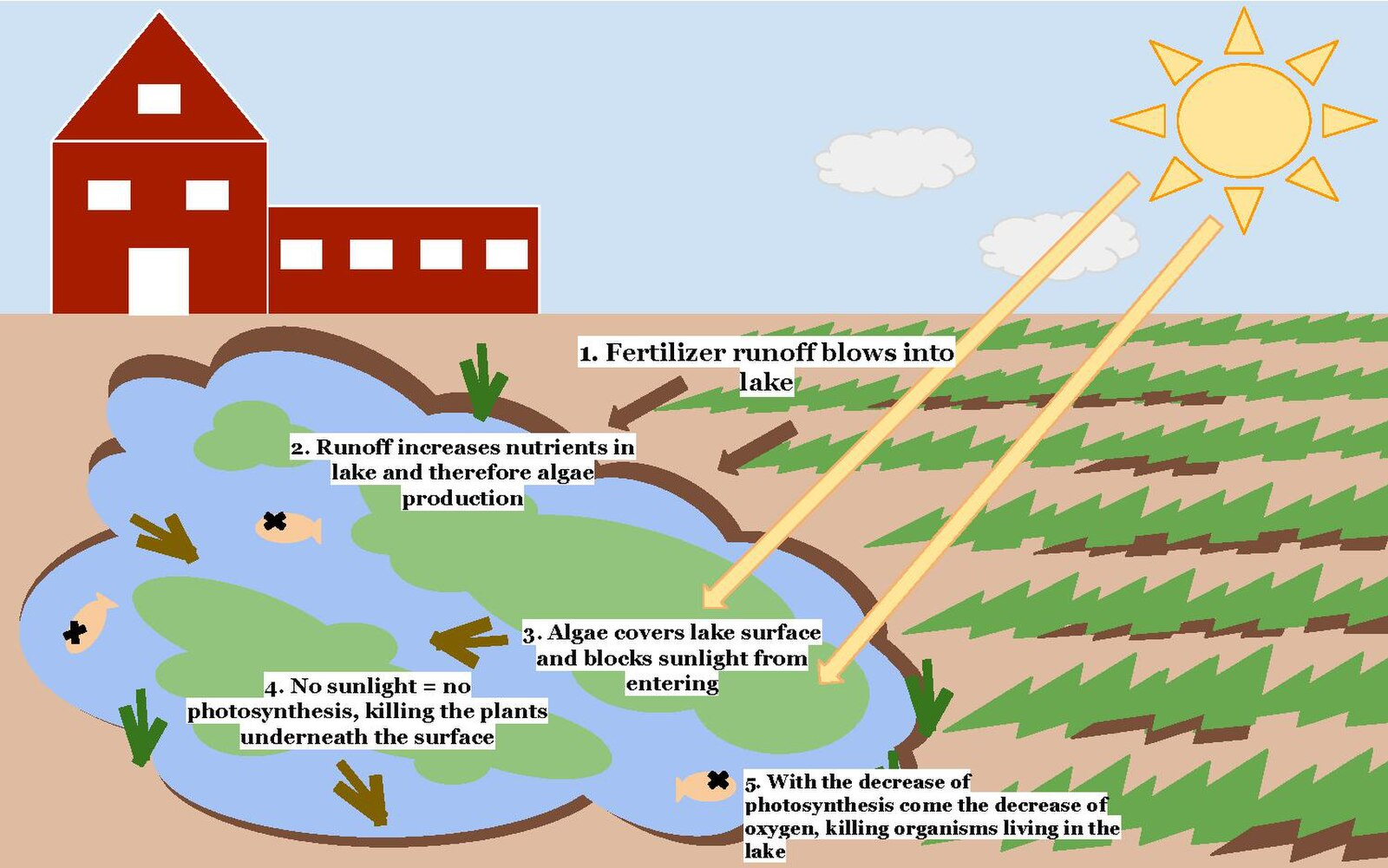Pollution is a critical environmental issue, intricately linked to various human activities. This section provides an in-depth examination of the roles that industrial processes, agriculture, and urbanisation play in the proliferation of pollution, offering insights into the specific mechanisms and impacts associated with each.
Industrial Processes
Manufacturing Emissions
Manufacturing industries are notorious for their significant contribution to environmental pollution. The release of a myriad of pollutants is a complex issue, affecting air, water, and soil.
Air Pollution
Gaseous Emissions: Factories release a cocktail of harmful gases, including sulphur dioxide and nitrogen oxides. These gases are primary contributors to the formation of smog and acid rain, leading to respiratory problems and environmental degradation.

This schematic shows SO₂ and NOₓ emitted by power stations, industries, and vehicles, their conversion in the atmosphere, and subsequent wet and dry deposition that acidifies soils and waters. It includes extra contextual detail on long-range transport and deposition forms, which goes slightly beyond the study note sentence but remains directly supportive. Source.
Particulate Matter: The release of fine particles into the atmosphere affects air quality, leading to health issues like asthma and other respiratory conditions.
Water Pollution
Chemical Discharges: Industries often release chemicals and heavy metals into water bodies. These substances can be toxic to aquatic life and contaminate water supplies, leading to a range of health and environmental issues.
Thermal Pollution: The discharge of hot water and fluids into rivers and lakes raises water temperatures, adversely affecting aquatic ecosystems.
Soil Pollution
Waste Disposal: The improper handling and disposal of industrial waste contribute to soil contamination, leading to a loss of soil fertility and the contamination of plant life.
Chemical Production
The chemical industry is another significant player in environmental pollution.
Hazardous Waste
Generation: The production of chemicals results in the creation of hazardous by-products. These materials, if not handled properly, can lead to severe environmental contamination.
Disposal: The improper disposal of chemical waste is a common issue, leading to soil and water pollution.
Toxic Emissions
Air and Water: Chemical plants emit toxic substances into the air and water, leading to a range of health issues and environmental degradation.
Mining Activities
Mining, while essential for extracting valuable minerals, is often associated with severe environmental pollution.
Land Degradation
Physical Alteration: Mining activities physically alter the landscape, leading to erosion, habitat destruction, and land pollution.
Chemical Pollution: The use of chemicals in mining processes can lead to soil and water contamination.
Water Contamination
Runoff: Mines often produce toxic runoff, carrying pollutants like mercury and arsenic into nearby water bodies, affecting aquatic life and human health.

Acid mine drainage discolours stream water with iron-oxide precipitates and dissolved metals, demonstrating how mining runoff contaminates aquatic systems. The orange hue is typical of AMD and helps visualise the water-quality impact discussed in the text. Source.
Agriculture
Use of Chemicals
Modern agriculture is heavily reliant on chemicals to enhance crop yield, but this comes at an environmental cost.
Pesticides
Contamination: Pesticides, while effective in controlling pests, often contaminate soil and water, impacting non-target species and ecosystems.
Bioaccumulation: These chemicals can accumulate in organisms, leading to toxic effects up the food chain.
Fertilisers
Nutrient Runoff: The excessive use of fertilisers leads to nutrient runoff, causing eutrophication in water bodies, leading to oxygen depletion and the death of aquatic life.

This diagram illustrates how nutrient runoff from agriculture stimulates algal blooms that block light and drive oxygen depletion, stressing or killing aquatic organisms. It matches the syllabus focus on fertiliser-driven eutrophication; minor additional detail includes reduced photosynthesis below the surface. Source.
Livestock Farming
Raising animals for food is associated with various forms of pollution.
Methane Emissions
Greenhouse Gas: Livestock, especially cattle, emit methane, a potent greenhouse gas that contributes significantly to climate change.
Waste Management
Contamination: The improper handling and disposal of animal waste can lead to water and soil pollution, impacting ecosystems and human health.
Land Use Changes
Agricultural expansion often involves the alteration of natural landscapes.
Deforestation
Carbon Emissions: Clearing forests for agriculture releases significant amounts of carbon dioxide, contributing to climate change.
Habitat Loss: The loss of forests also means the loss of habitat for countless species, leading to biodiversity loss.
Soil Erosion
Sedimentation: The removal of vegetation exposes soil to erosion, leading to sedimentation in water bodies and the loss of soil fertility.
Urbanisation
Transportation
The growth of cities is closely tied to increased transportation, contributing to air and noise pollution.
Vehicle Emissions
Air Quality: The emissions from cars, buses, and trucks, including carbon monoxide, nitrogen oxides, and particulate matter, severely impact air quality and human health.
Climate Change: Transportation is a significant source of greenhouse gas emissions, contributing to global warming.
Noise Pollution
Health Impacts: The constant noise from vehicles affects mental and physical health, leading to issues like stress, anxiety, and hearing loss.
Construction Activities
Urban development and construction are sources of air, water, and soil pollution.
Dust and Particulates
Air Pollution: Construction sites release significant amounts of dust and particulates into the air, contributing to respiratory issues and environmental degradation.
Chemical Runoff
Water Pollution: The use of chemicals in construction processes can lead to runoff, contaminating nearby water bodies and soil.
Waste Generation
Urban areas generate significant amounts of waste, leading to pollution if not managed properly.
Solid Waste
Land Pollution: The improper disposal of solid waste contributes to land pollution, affecting ecosystems and human health.
Plastic Pollution: The proliferation of plastic waste is a significant issue, affecting oceans, wildlife, and ecosystems globally.
Wastewater
Water Contamination: Cities produce large volumes of wastewater. Inadequate treatment and disposal lead to the contamination of water bodies, affecting aquatic life and human health.
In this detailed exploration of the causes of pollution, the intricate links between human activities and environmental health are laid bare. Each sector, from industrial processes to agriculture and urbanisation, presents unique challenges that require targeted interventions to mitigate pollution and safeguard both environmental and human health. The imperative for sustainable practices is underscored, highlighting the need for comprehensive strategies to address the multifaceted issue of pollution in our world today.
FAQ
Transportation, especially road traffic, is a major source of noise pollution in urban areas. The constant noise from vehicles can lead to health issues, including stress, sleep disturbances, and hearing loss. Cities can address this issue by implementing measures such as traffic management to reduce congestion, promoting the use of public transport, and developing green spaces to absorb sound. Additionally, enforcing stricter regulations on vehicle noise emissions and encouraging the adoption of quieter, electric vehicles can significantly mitigate noise pollution associated with transportation.
Household activities, including the improper disposal of chemicals and waste, can lead to water pollution. For instance, pouring chemicals down drains or excessive use of detergents and cleaners can contaminate water supplies and harm aquatic ecosystems. Individuals can mitigate this issue by properly disposing of household chemicals at designated disposal facilities and opting for eco-friendly, biodegradable cleaning products. Additionally, reducing water usage and avoiding the disposal of medicines, paints, and other hazardous materials into the water system can significantly minimise household contributions to water pollution.
Agricultural runoff, rich in fertilisers, and industrial discharges containing various chemicals, often lead to the eutrophication of water bodies. This process involves the excessive enrichment of water with nutrients, leading to algal blooms, oxygen depletion, and the death of aquatic life. To address this, regulations to manage and reduce the use of fertilisers and chemicals in agriculture and industry are crucial. Implementing buffer zones around water bodies to absorb and filter runoff, and promoting the use of sustainable farming and industrial practices that minimise pollution, can effectively mitigate eutrophication.
Waste management, especially the improper disposal of solid waste, significantly contributes to land pollution. Landfills, if not well-managed, can lead to the leaching of hazardous chemicals into the soil, affecting its quality and contaminating groundwater. To minimise this impact, recycling and composting should be promoted to reduce the volume of waste sent to landfills. Additionally, the implementation of stricter regulations for waste disposal and the development of more sustainable waste management technologies, such as waste-to-energy conversion, can play a pivotal role in reducing land pollution associated with waste management.
The energy sector, particularly fossil fuel-based power generation, is a significant contributor to air pollution. The burning of coal, oil, and natural gas releases a plethora of pollutants, including sulphur dioxide, nitrogen oxides, and particulate matter. These substances degrade air quality, leading to health issues and environmental problems like acid rain. To mitigate this, transitioning to cleaner energy sources such as wind, solar, and hydroelectric power is essential. Implementing stricter emission standards for power plants and promoting energy efficiency and conservation practices can also significantly reduce pollution from the energy sector.
Practice Questions
Industrial processes significantly contribute to environmental pollution through the emission of harmful gases, chemicals, and particulates. For instance, factories often release sulphur dioxide and nitrogen oxides into the air, leading to the formation of smog and acid rain, which adversely affect both human health and ecosystems. Water bodies are not spared either; industrial discharges containing heavy metals and chemicals lead to water contamination. Soil pollution is also a concern, resulting from the improper disposal of industrial waste, affecting soil fertility and plant growth. Each of these pollution types underscores the urgent need for stringent regulations and sustainable practices in industries.
Agriculture plays a significant role in environmental pollution, particularly through the use of chemicals and land use changes. Pesticides, often used to control pests, can contaminate soil and water, impacting non-target species and ecosystems. An example is the runoff of pesticides into rivers, leading to the death of aquatic life and the disruption of aquatic ecosystems. Fertilisers, too, are a concern; their excessive use results in nutrient runoff, causing eutrophication in water bodies. Deforestation, a consequence of agricultural expansion, leads to habitat loss, biodiversity reduction, and increased carbon dioxide emissions, exacerbating climate change.

